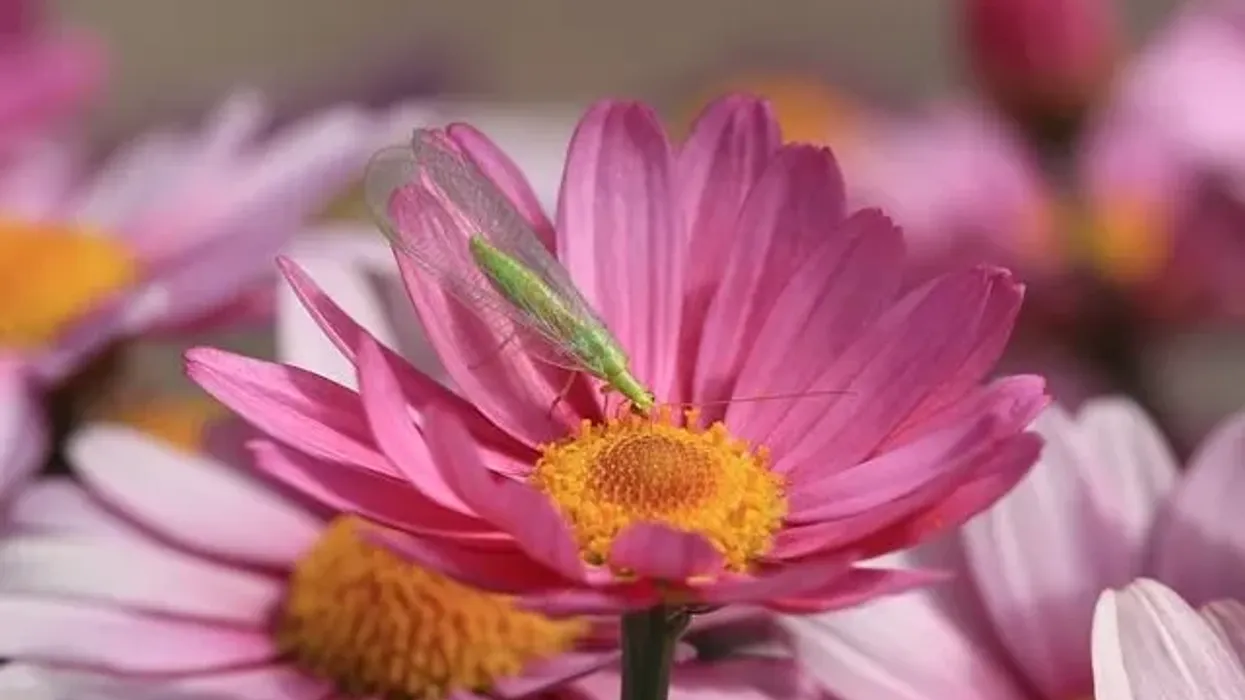The green lacewing (Scientific name: Chrysoperla rufilabris) is a delicate, light green-colored insect with two large wings belonging to the Chrysopidae family. This species was discovered by taxonomists and citizen scientists.
With predator instincts, the lacewing larvae are considered to be beneficial for pest management.
They help to reduce the disturbance of pests in the gardens and agricultural fields. Green lacewing larvae scavenge plants for prey, such as insect eggs and other aphids and small soft-bodied insects like whitefly or spider mites after they have hatched, while the adults feed on nectar, pollen, and honeydew from flowers and plant saps.
This is the reason why the lacewing larvae are known as aphid lions.
The larvae, being a predator, strike their prey ferociously and then suck out the pest's body secretions and kill it. They are rare but very important for pest control.
Green lacewing egg is viable as the most widely distributed predator of pests.
The lacewing eggs should be released in the release area during the early morning hours or after sunset because they will not thrive in extreme heat. The best outcome will come if the green lacewing eggs are released right away, but if that isn't possible, they can be kept in the refrigerator for not more than 48 hours.
The average lifespan of an adult lacewing is between four and six weeks. Read on to know more about these beneficial predator facts. If you like reading this article, you may also like to read about the Mormon cricket and the black carpenter ant.
Green Lacewing Interesting Facts
What type of animal is a green lacewing?
The green lacewing is an insect that is known to be very effective for pest control.
What class of animal does a green lacewing belong to?
Green lacewings belong to the class of Insecta, or insects, and to the phylum arthropods.
How many green lacewings are there in the world?
There is no record of the number of green lacewings present in the world. There are about 1,300 species divided into 87 genera all over the world. The Chrysopidae is a large and economically important family of Neuroptera.
Where does a green lacewing live?
Green lacewings can thrive in any vegetation, particularly in grasslands, agricultural lands, trees, and bushes. They can be found in parks, fields, as well as in forests. Different species of lacewings of the Neuroptera order live all over the world and especially in the USA.
What is a green lacewing's habitat?
The green lacewing's habitat is grassy fields, shrubs, and other vegetation. Green lacewings usually fly at night as they are nocturnal and therefore relax during the day.
Many flying insects are attracted to light at night, and this species is no different. These beneficial insects are well adjusted to a wide range of climates all year long.
Lacewings are predators and are effective for pest management. They are bred in two ways to protect the crops from pests. One of the natural ways to attract them is by planting sunflowers or allowing weeds like dandelions to grow near them.
But sometimes, it's difficult to wait for these predators to come naturally and so lacewing eggs are released on crops. Therefore, they are treated as biological control agents.
Who do green lacewings live with?
These predators are not social and prefer to be on their own unless it's the mating period.
How long does a green lacewing live?
Adults have a lifespan of between four and six weeks depending on the climate and the quality of food.
How do they reproduce?
The mating of lacewings can be quick or can take hours. The female adults lay their eggs in an area under the leaves or on thin stems at night.
The green lacewing eggs hatch after four or five days and lacewing larvae appear who are prepared to kill aphid pests and other insect species, like mites. The eggs are usually green when they are laid, but they darken right before they hatch.
Lacewings go through a complete metamorphosis where the larvae have evolved and molted several times, they spin a cocoon underneath a leaf and pupate, eventually developing as winged adults. These adults mate again and thereby the green lacewing life cycle continues.
What is their conservation status?
The conservation status of the green lacewings is Not Listed by IUCN (International Union of Conservation of Nature) but in many countries, a few species from the order Neuroptera like Nothochrysa California are considered Endangered according to the regulatory bodies of the respective countries.
Green Lacewing Fun Facts
What do green lacewings look like?

The adult lacewings have long, delicate wings that form a roof over the body when it is folded during its resting period. They are called 'lacewings' because their wings look like delicate laces consisting of a web of cross-veins.
They are pale green, greenish-brown or tan colored with a slender body and long antennae. Their eyes are golden or copper in color.
An adult green lacewing size is 0.4-0.6 in (1-1.5 cm) while larvae can grow up to 0.5 in (12.7 mm). Lacewing larvae resemble mini alligators because of their long, flat bodies with strong and protruding pincers. Green lacewing pincers catch prey in a unique way.
The hollow pincers grip their prey, inject a venom that makes the prey paralyzed. Then, they suck the body fluids of the pests.
How cute are they?
Yes, the green lacewings are cute and beneficial insects with delicate and lacy wings along with a subtle pale green-colored body.
How do they communicate?
Green lacewing insect communicates through smell and sound sensations but sometimes visual perception is possible too. During courtship, they make noise by vibrating their bodies and sing 'duets' by exchanging calls.
How big is a green lacewing?
These adult insects are 0.4-0.6 in (1-1.5 cm) in size, about 3 times bigger than a housefly.
How fast can a green lacewing run?
They have a sluggish flight as they fly at a speed of 2.7 kph.
How much does a green lacewing weigh?
Lacewings are so small in size that their body weight could not be calculated and can be considered negligible.
What are their male and female names of the species?
The male and female of the species do not have any significant names.
What would you call a baby green lacewing?
A baby green lacewing is known as a larva. Colloquially it is also referred to as an 'aphid lion' as it fiercely kills aphids and other soft-bodied insects with its large and protruding pincers.
What do they eat?
The green lacewing larvae are predators who prey on various insect eggs and soft-bodied insect pests like aphid, mealybugs, mites, small caterpillars but not mosquitoes while the adults enjoy nectar, pollen, and honeydew from flowers and plant saps. The lacewing larvae aggressively strike their prey and catch them with huge, grinding pincers.
Then, they inject a poison that makes the pest paralyzed. Lastly, they kill the pest by sucking the pest's body fluids with their hollow pincers.
Are they poisonous?
These insects are harmless to humans, but they are poisonous to other insect pests in your backyard or agricultural fields. The lacewing larvae consume aphids and other soft-bodied pest insects such as mealybugs, whiteflies, and mites.
Would they make a good pet?
Since they are very small, they cannot be kept as a pet but these insects are good for pest management since they eat aphids and other small insects. Therefore they are treated as biochemical agents and are bought by gardeners and farmers to protect their gardens and crops from pests.
One should contact a pest control specialist to buy green lacewing larvae, green lacewing eggs, or adults.
Did you know...
Another name of these insects is 'stinkflies' because they emit a foul-smelling odor when they are touched by some species.
What is another name for green lacewings?
Another name for green lacewings is 'aphid lions' because they vigorously capture aphids and other small-bodied insects with their sharp and hollow jaws, eventually injecting a venom that paralyzes them. Lastly, they suck the body fluids of their prey and kill them.
How many aphids can a green lacewing eat in a day?
They can consume around 200 aphids and other soft-bodied insects in a day for two or three weeks before spinning a cocoon and returning 10-14 days later as adults.
Here at Kidadl, we have carefully created lots of interesting family-friendly animal facts for everyone to discover! Learn more about some other arthropods including the darkling beetle and the stick bug.
You can even occupy yourself at home by drawing one of our Green Lacewing coloring pages.










